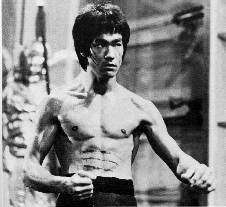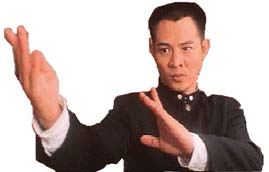CLICK HERE TO GO TO BEIJINGWUSHUTEAM.COM
Fists of Legend and Fury: What Asian American
College Students Can Learn from Jet Li and Bruce Lee
by
Glenn Omatsu
Originally appeared in "Pacific Ties, the UCLA Asian Pacific Islander
Newsmagazine." Reprinted with author's permission
 Late 1972 in a small movie house in S.F. Chinatown: It's
opening week for Bruce Lee's "Fists of Fury" (renamed
"Chinese Connection" in the U.S.), but there are no stretch
limos or Hollywood stars here. This audience consists of
middle-aged Chinese immigrants -- most of them garment
workers, laundrymen, and waiters from nearby restaurants --
who have come to be entertained after a hard day of work.
They are here to see a film set in Shanghai in the 1920s and
to watch a Chinese American actor who has become a Hong Kong
star after two movies. All is quiet until the scenes where
Lee destroys a framed calligraphy penned by Japanese
imperialists declaring Chinese the "sick man of Asia" and a
sign stating "no dogs or Chinese allowed here." The crowd
responds with loud, sustained applause.
Late 1972 in a small movie house in S.F. Chinatown: It's
opening week for Bruce Lee's "Fists of Fury" (renamed
"Chinese Connection" in the U.S.), but there are no stretch
limos or Hollywood stars here. This audience consists of
middle-aged Chinese immigrants -- most of them garment
workers, laundrymen, and waiters from nearby restaurants --
who have come to be entertained after a hard day of work.
They are here to see a film set in Shanghai in the 1920s and
to watch a Chinese American actor who has become a Hong Kong
star after two movies. All is quiet until the scenes where
Lee destroys a framed calligraphy penned by Japanese
imperialists declaring Chinese the "sick man of Asia" and a
sign stating "no dogs or Chinese allowed here." The crowd
responds with loud, sustained applause.
Early 1974 in a giant "second-run" movie theater in a
deteriorating section of downtown S.F.: Bruce Lee has been
dead for more than six months, but his legend in America is
growing and his first and only U.S.-produced film, "Enter
the Dragon," now draws multiracial crowds. This theater is
packed with inner-city youth -- Black, Asian, and Latino
males. The floor of this theater is so sticky that you can
hardly move your feet. Throughout the film, the crowd
cheers raucously, especially when Bruce Lee beats up legions
of villains and Black martial artist Jim Kelly takes out two
racist cops. After the show, youth spill out into the
streets practicing Bruce Lee moves.
Early 1998 in Chinese immigrant video stores across America:
There is a new martial arts legend in Chinese immigrant
communities, and he's not Jackie Chan. With charisma,
grace, and explosiveness, Jet Li of the People's Republic of
China has established his name in the crowded field of
martial arts actors. Although best known for "Once Upon a
Time in China," Jet Li's 1995 homage to Bruce Lee called
"Fist of Legend" is regarded as a classic among many
immigrants, especially youth. However, this film -- and Jet
Li himself -- is largely unknown to another sector in our
community: Asian American college students.
Revenge. Honor. Patriotism. These are words that
most would use to describe Jet Li's "Fist of Legend" and its
predecessor, Bruce Lee's "Chinese Connection" -- two
action-packed films from different eras of Hong Kong cinema.
Of course, there are those who will dismiss these films as
simply "martial arts films." They are that, but they are
more. Contained in both is an intricate political message
-- one with special significance for the destiny of young
Asian Americans today.
On the surface, the plot of these movies is basic Kung
Fu Theater. A martial arts student, Chen Zhen, seeks to
avenge the poisoning of his master in Shanghai in the 1920s.
However, what begins as an individual pursuit of vengeance
evolves into a patriotic crusade when the student learns
that those responsible for his master's death are Japanese
imperialists who are establishing their dominance over
China.
In "Chinese Connection," Bruce Lee gives an intense
performance as the tormented and driven Chen Zhen. While
others in his martial arts school are unsure how to respond
to the death of their master and the growing oppression
around them, Bruce Lee's character acts decisively. He
demolishes single-handedly Japanese imperialists, their
Russian cohort, and their Chinese collaborators.
 Jet Li's "Fist of Legend" is not a simple remake of the
Bruce Lee classic; rather, it is an extension of the Chen
Zhen legend. Most viewers will quickly notice that unlike
"Chinese Connection," the Japanese characters in this film
are not all evil, vicious, and decadent. Yet, the
redefinition of the Japanese in the film speaks to a larger
theme. Here, resistance against imperialism is no longer
simply the activity of one heroic individual; instead, it is
the collective actions of many. Jet Li's Chen Zhen is
clearly the center of this film, yet his heroic actions are
framed by the equally heroic activities of others.
Jet Li's "Fist of Legend" is not a simple remake of the
Bruce Lee classic; rather, it is an extension of the Chen
Zhen legend. Most viewers will quickly notice that unlike
"Chinese Connection," the Japanese characters in this film
are not all evil, vicious, and decadent. Yet, the
redefinition of the Japanese in the film speaks to a larger
theme. Here, resistance against imperialism is no longer
simply the activity of one heroic individual; instead, it is
the collective actions of many. Jet Li's Chen Zhen is
clearly the center of this film, yet his heroic actions are
framed by the equally heroic activities of others.
"Fist of Legend" begins and ends with two linked images
related to this theme. At the beginning, a group of
Japanese students pass out leaflets in Kyoto, declaring that
"Japan belongs to the people, not the Emperor!" -- only to
be dispersed by a group of thugs. At the end of the film,
Chen Zhen is spirited out of Shanghai by supporters to
continue efforts to organize against the Japanese
imperialists. And since this film is titled "Fist of Legend
1," it is likely that a sequel will continue the saga of
Chen Zhen and Chinese and Japanese patriots who oppose
imperialism.
These two films are, after all, ferocious fighting
films designed to showcase the talents of their stars, and
viewers seeking intricately choreographed fights will not be
disappointed. Several scenes deserve mention. Near the end
of "Chinese Connection," Bruce Lee defeats a seemingly
invincible Russian opponent. His victory symbolizes China's
ability to not only stand up against Japanese oppressors but
western imperialists as well. In the second half of "Fist
of Legend," Jet Li battles two different Japanese opponents.
The first is a karate master who is his senior in both age
and experience. This fight is characterized by honor. At
one point, Chen Zhen blindfolds himself so as not to take
unfair advantage of his opponent blinded by a dust storm.
The duel between the two masters ends without a winner,
although through this experience Chen Zhen learns from his
opponent that he will need to develop both a defense and
offense to defeat the Japanese imperialists. This knowledge
prepares Chen Zhen for the climactic fight in the film, his
battle with the sadistic Japanese general -- the symbol of
fascism and militarism.
"Fist of Legend" and "Chinese Connection" are important
films for Asian American college students today -- not
because they relate to so-called "Asian heritage" but
because they are political. But will Asian American youth
have the political consciousness and historical
understanding to truly appreciate these films? Or will they
see them simply as other Americans do -- as "martial arts
films"?
To truly appreciate these films, Asian American college
students need to learn from an often ignored sector of our
community: immigrant garment workers, waiters and
waitresses, laundrymen, and small merchants. These were the
first in America to embrace Bruce Lee and, today, they are
the first to appreciate Jet Li. They are the people who can
teach all of us the significant political message of these
films: namely, the power of individuals to fight oppression
and, in the process, to inspire others to discover the
fighting spirit within themselves.
Webmaster's Note: I don't necessarily agree with the author's viewpoint in this issue.
for example I feel the impact of these movies on Chinese-Americans is much different then
the impact on Japanese-Americans.
Revived 1/11/00
 Late 1972 in a small movie house in S.F. Chinatown: It's
opening week for Bruce Lee's "Fists of Fury" (renamed
"Chinese Connection" in the U.S.), but there are no stretch
limos or Hollywood stars here. This audience consists of
middle-aged Chinese immigrants -- most of them garment
workers, laundrymen, and waiters from nearby restaurants --
who have come to be entertained after a hard day of work.
They are here to see a film set in Shanghai in the 1920s and
to watch a Chinese American actor who has become a Hong Kong
star after two movies. All is quiet until the scenes where
Lee destroys a framed calligraphy penned by Japanese
imperialists declaring Chinese the "sick man of Asia" and a
sign stating "no dogs or Chinese allowed here." The crowd
responds with loud, sustained applause.
Late 1972 in a small movie house in S.F. Chinatown: It's
opening week for Bruce Lee's "Fists of Fury" (renamed
"Chinese Connection" in the U.S.), but there are no stretch
limos or Hollywood stars here. This audience consists of
middle-aged Chinese immigrants -- most of them garment
workers, laundrymen, and waiters from nearby restaurants --
who have come to be entertained after a hard day of work.
They are here to see a film set in Shanghai in the 1920s and
to watch a Chinese American actor who has become a Hong Kong
star after two movies. All is quiet until the scenes where
Lee destroys a framed calligraphy penned by Japanese
imperialists declaring Chinese the "sick man of Asia" and a
sign stating "no dogs or Chinese allowed here." The crowd
responds with loud, sustained applause.